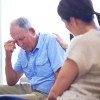How Did We Get Here? A Look at America’s Opioid Crisis

Photo credit: Getty Images
Last year more than 75,000 Americans died from opioid overdose, and the predictions for this year are even higher. It’s currently the number one cause of death for Americans under the age of 50. “It’s a crisis of biblical proportions,” says Dr. Joseph Garbely, the Vice President of Medical Services and the Medical Director at Caron Treatment Centers. “This is an epidemic everyone needs to pay attention to.”
To put this crisis into perspective, Kate Appleman, the Senior Clinical Director for Men’s Treatment Services at Caron explains, “These stats show more deaths than at the height of the AIDS epidemic. You’re talking about more deaths than homicides or motor vehicle accidents in a year combined,” she says. “The number is huge.”
So how did our society get here, and why are so many of our friends, neighbors and family members dying from the most preventable and treatable chronic illness—addiction? Overprescribing for starters, particularly for chronic pain conditions. “America uses 80 percent of the world’s opioids and 99 percent of the world’s hydrocodone,” says Garbely. “Either we’re doing something wrong or the rest of the world is in excruciating pain, which I doubt.”
The prescribing of opioids to treat chronic pain is the root of where most American addiction cases began. “The first phase of the epidemic was the prescription opioid phase and we, as physicians really fed into that, all with good intentions to treat pain” says Garbely. “But we overwrote and as a result the next generation was exposed to prescription opioids.”
From there, patients who become addicted will start to look to family and friends medicine cabinets when their supply runs out, then to the street to buy the drugs they were prescribed. That gets expensive so they turn to heroin, which is cheap and eventually end up on synthetic opioids, like fentanyl and its congeners, which are even cheaper but much more potent. These generally lead to very serious addictions and overdose deaths.
But it’s important to remember that opioid addiction is so much more than heroin or fentanyl abuse. “It’s teens having a pill party, athletes that sustain a sports injury, older adults who are hooked on pain medication,” says Appleman. Dr. Dean Drosnes, the Associate Medical Director and Director of the Chronic Pain Program at Caron agrees, “The 65-year-old on prescription opioids for five years is not newsworthy, but the arrest of a heroin dealer on a college campus and the overdose deaths is,” he says. “It’s important to acknowledge all facets and help get these individuals into stable recovery. It’s the only way we’re going to get out of this epidemic.
It’s okay to not be a professional on opioid addiction but if you suspect something is wrong with yourself or a loved one, say something anyway. Use the resources available in your community and ask for help from experts, “ says Appleman. “The symptoms include significant weight-loss, unaccounted for time, a change in complexion, personality changes and the typical symptoms that come from addiction.” When it comes to opioids, it’s better to act proactively than wait for something to happen.
If you suspect that you or a loved one is struggling with an addiction, it is never too early to take the next step and learn more about this disease. Visit Caron.org to learn more and get connected with a professional. We are Caron. Real About Recovery.
This is a paid partnership between Caron Treatment Centers and Philadelphia Magazine


